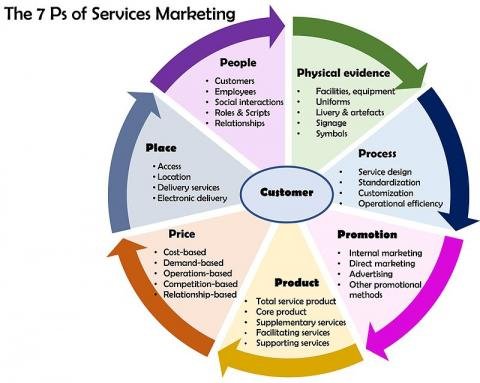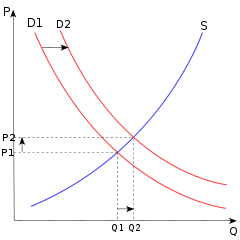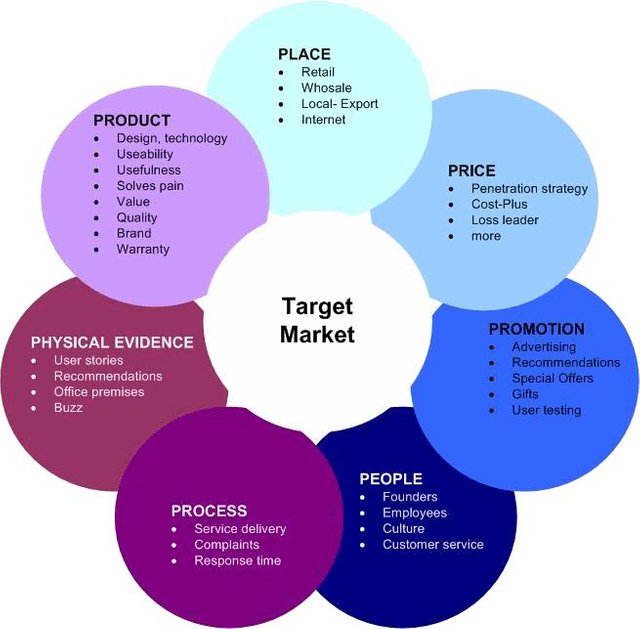The 4 Ps of marketing: The marketing mix
Hi everyone :)
Product, Price, Place, Promotion - these 4 words refer to a set of actions/tactics a company uses to promote their service or good at the right time at the right place for the best price, fulfilling the costumers need and gain the highest profits.

the classical marketing mix changed over the time and nowadays there are the 7 P's shown on the illustration
Product
Before you can sell something, you need a product first. As on a costumer market, wishes and expectations change, choices have to be made. Every action, choice and consideration related to the product is directly related to this category. The product development, its attributes and the product life-cyle are as important as packaging, quality and services combined to the product (phone + case/communication contract...).
Changing demands lead to range planning, to avoid over/underproduction. Marking products with a new name is also part of the product policy. Strategies can reach from product innovations such as incorporating a new technology to changing attributes e.g. the color of a shoe. But not only decission which try to maintain the product are made, but also eliminations of variations or even the whole series have to be considered if it isn't worth producing anymore.

two cookies with different attributes
Price
Every decision related to the price development can be found under this category. This "P" focuses on sales policy and therefore deals with demand, concurrence and product costs. Taxes, variable costs (material, working power, transportation costs...), a profitable extra costs to earn enough money as an example, (in a simplified calculation) equal the price a product will be sold for in the future. Companies follow the market and use appropriate tools to take advantage. One of this tools is the price differentiation which can be split into personnel (services is cheaper for students), amount (buy 5 pay 4), spatial (different purchasing power) and temporal (mid-summer sale) differentiation. Price policy is also focusing on terms of payment or delivery conditions.

pricing has to keep the balance between how much people are willing to pay and a good price to earnings ratio
Place
You can develop the most efficient, fastest and best boat the world has seen, if you try to sell it in a desert region, chances are high that it will be a flop. Because of this reason, distributional policy evaluates over which channels and markets a service/product will be marketed. Depending on the financial power of the company, transportability or explanation needed, some ways are more suitable than others. Some companies sell their product directly (internet, store...), others prefer selling it by a dealer (mail-order, chain of companies, representatives, cataloque...).

some products have higher chances to be sold at certain regions/markets than others
Promotion
Informing a targeted audience with information about the brand/service or product is part of promotion. The aim is to increase awareness, generate sales or form a relation between the costumer and the brand. This category is differed into 5 ways of promoting:
1. Advertising
(TV-spots, radio, magazines & newspapers, flyers, posters, billboards, direct mail, webpages, social media, stands, influencers, stickers...)
2. Public relations & Sponsoring
Earning sympathy from external stakeholders is essential and therefore companies try to increase positive mention of their product by doing interviews, sending products to bloggers or influencers. doing cooperation events with e.g. suppliers or hosting public events. Sponsoring events or people can be a positive factor too, using the fanbase of them to raise attention towards the brand. Another advantage is, this kind of promotion can be very cheap in comparison to the possible increase of demand.

events for new products are common in many industries from testing an to presentations of a new car
3. Sales Promotion
Limited offers like a 20%-off discount, contests or special packagings and samples targeting more sales during this time. Coupons and loyal discounts act as an incentive for costumers too.
4. Personal Selling
Aiming to directly sell a product during an interaction with consumers by person,email or via chats.
5. Direct marketing
Individually addressing consumers with things like personalised letters, e-mails, phone calls, messages at already existent or potential costumers.
Conclusion
All these different tools lead to the marketing mix which controlls management decissions and was modified over the time to increase it's effectivity:

Thanks for reading :)
SourceTexthttps://de.wikipedia.org/wiki/Marketing-Mix (translated)https://de.wikipedia.org/wiki/Preisdifferenzierung (translated)https://wirtschaftslexikon.gabler.de/definition/produktpolitik-44161 (translated)https://www.cleverism.com/promotion-four-ps-marketing-mix/https://en.wikipedia.org/wiki/Promotion_(marketing)https://smartmarketingbreaks.eu/was-ist-der-marketing-mix/ (translated)Pictureshttp://www.kinginfolife.com/sites/default/files/styles/large/public/7_ps_of_services_marketing.jpg?itok=FDAkLkDUhttps://www.mises.se/wp-content/uploads/Supply-and-demand.pnghttp://narrotibi.com/wp-content/uploads/2016/12/Kekse_backen_Titel-600.jpghttps://cdn.pixabay.com/photo/2017/06/16/11/29/buggy-2408784_960_720.jpghttps://cdn.pixabay.com/photo/2017/12/08/11/53/event-party-3005668_960_720.jpg https://upload.wikimedia.org/wikipedia/commons/d/d3/7ps-marketing-ps.jpg
Marketing in a nutshell, interesting and to the point. Thanks! Can probably be grafted onto a business plan.
@tmayd thanks for your positive feedback :)
Hey! Thanks for this one. I hope my followers will resteem that too.
Thanks for resteeming :) @megan93